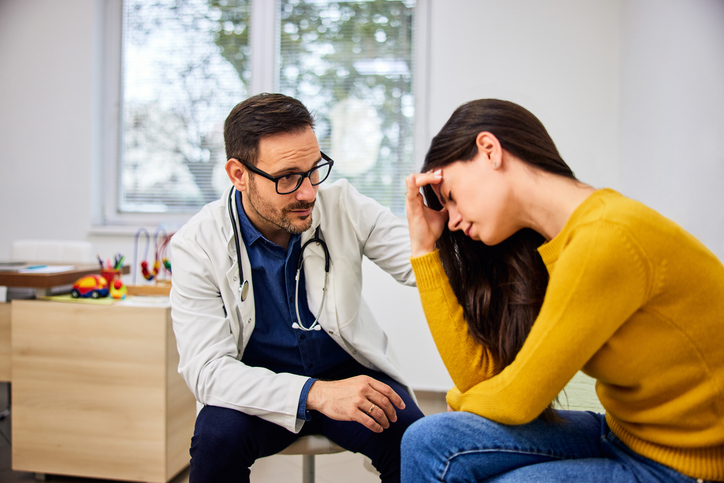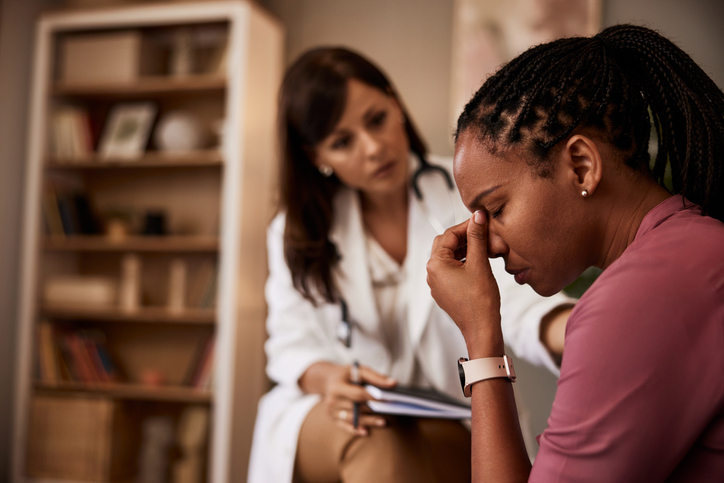Endometriosis can be a real pain — literally. And getting a diagnosis? That process can be even worse! On average, receiving an official diagnosis takes 7 to 10 years from the onset of symptoms. That’s way too long to live with pain and uncertainty about what’s going on with your body.
The good news? The more you know about how endometriosis is diagnosed, the better you can advocate for yourself. So, we’re breaking it down — including what to expect during the process and even some surprising new testing options you need to know about.

First, what are the symptoms of endometriosis?
Diagnosing endometriosis, which many refer to as “endo,” usually begins when you notice symptoms like severe menstrual cramps, pain during sex, chronic pelvic pain, or even difficulty getting pregnant.
Despite advancements in endometriosis research, some providers lack up-to-date training, and many mistakenly believe its symptoms (specifically, heavy, painful periods) are ‘normal.’
“This normalization delays proper clinical diagnosis preventing a referral to an endometriosis specialist who may suggest excision surgery or sometimes just medication to manage the pain. Some patients may even begin to downplay their own pain, leading to numerous years of undiagnosed symptoms,” explains Dr. Tara Harding, a doctorate family nurse practitioner, fertility coach, and medical advisor at MyReceptiva.
Endo symptoms can also vary widely from person to person — some women might experience debilitating pain, while others might have mild discomfort or no pain at all.
“Many young women have such significant symptoms that they miss school and activities or are told to push through and ‘suck it up.’ I remind patients that menstrual pain is not normal and that they have the right to be heard,” empathizes Harding.
Your first appointment with an endometriosis specialist
To start, your provider will want to hear your story. They'll ask all about your symptoms, including when they started and anything else that might be relevant to your health. Keeping a symptom diary for a few months before your appointment can be helpful, noting when pain occurs and any factors that seem to trigger or worsen it.
Harding says she starts by validating her patients’ experience. ”I set the exam room to be calming and welcoming. I emphasize that their symptoms are real and that they deserve to be taken seriously,” she says. “I encourage them to bring a detailed symptom diary, medications, providers, and any history they may have, including family history. I work with them to create an action plan that they are comfortable with. I then see my patients every 4-6 weeks to ensure what we do is working, and all questions are answered.”
Your provider will also perform a physical exam, which may include a pelvic exam. This can be uncomfortable, especially if you're experiencing pain, but it's an important step in ruling out other conditions and identifying potential endometriosis indicators.
One of the most exciting developments in endometriosis detection is the MyReceptiva test, which looks for the presence of BCL6, a marker highly associated with endometriosis and supported by 8 years of clinical use in the infertility space (but is now available to everyone!).

Endo diagnostic tests
An inside look with imaging
The next step often involves tests like a transvaginal ultrasound, which is commonly used to look for endometriomas, cysts caused by endometriosis, or other pelvic abnormalities. While ultrasound cannot definitively diagnose all types of the condition, it's really good at spotting things like ovarian cysts and deep infiltrating endometriosis, where the tissue grows into your other organs.
Sometimes, your doctor might even recommend an MRI to get more detailed images and help identify deep endometriosis lesions that might not appear on ultrasound.
Laparoscopy for diagnosis
Traditionally, the only way to definitively diagnose endo has been through laparoscopic surgery, which allows the surgeon to visualize any lesions and take tissue samples for biopsy. While laparoscopy is minimally invasive, it's still a surgical procedure with associated risks and recovery time.
MyReceptiva, a non-invasive option
Exciting research developments mean new detection options, like MyReceptiva which uses a protein marker called BCL6 to look for inflammation on the uterine lining most often associated with endometriosis, even when endo may not be visible on your imaging scans. This test involves a simple endometrial biopsy, typically performed in your provider’s office.
While it's not a definitive diagnosis on its own, it has incredible specificity (accuracy) and can provide valuable information to guide further testing or treatment decisions. And it can be particularly helpful for women who are considering fertility treatments.
“This test can give us clues if endometriosis may be the cause of their symptoms,” says Harding. Some women have travel or insurance restrictions, making surgery a big step. “If positive, we can create a better plan and give them some insight,” says Harding.

What do your results mean?
Your provider will explain the results once you've undergone the diagnostic process. If your results suggest endometriosis, your provider will walk you through the next steps and discuss your best treatment options.
“This includes whether their insurance covers surgery, when they can travel to get to a true excision specialist, and what else can we do right here and now to help them with these results,” says Harding. “Depending on their symptoms and goals, this could include supplements, dietary changes, medications, acupuncture, pelvic floor physical therapy, or even for some, mental health services.” For those hoping to get pregnant, this may entail fertility treatments like IVF.
Endo can be a tricky condition to diagnose, and sometimes, it takes a bit of persistence to get the answers you need. Don't hesitate to get a second opinion or learn how you can order the MyReceptiva kit ahead of time and go to your provider to get tested. Advocacy is essential!
Endometriosis treatment and management
Remember, a diagnosis is just the beginning. Endometriosis is a chronic condition, but with proper management, many women find significant relief from their symptoms.
“When discussing options, I review each approach including risks, benefits, and limitations, highlighting that while non-invasive testing can indicate a likelihood of endometriosis, laparoscopy remains the gold standard for diagnosis and treatment,” says Harding. “However, non-invasive options like MyReceptiva can provide insight without surgery, which is a huge win for so many women.”
Taking control of your health
Getting an endo diagnosis can be lengthy and frustrating, but understanding what to expect can help you get through it more confidently.
Harding recommends being persistent and advocating for additional testing or specialist referrals if you have concerns. “Social media has been great to raise awareness on this disease from healthcare providers but also other patients,” she says.
Millions of women worldwide are living with endometriosis, and there are plenty of resources and support available. Take control of your health and work towards a better quality of life — and remember, you know your body best.
Blair Sharp is a freelance writer who lives in Minnesota with her husband and son. Her words have been published in various publications, including Parents, SheKnows, The Bump, and Insider. You can find her watching reality TV and sharing too many reels with her friends when she's not writing. To connect with Blair, find her on LinkedIn and Instagram, or head to her website www.blairsharp.com.

.webp)



















